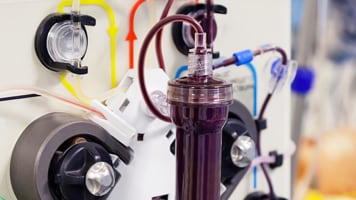Key points
- Streptococcal toxic shock syndrome (STSS) is a rapidly progressing infection involving shock and multi-organ failure.
- Diagnosing STSS can be difficult and patients are often misdiagnosed.
- Treatment focuses on addressing issues with shock and specific organs that are failing.
- Treatment includes antibiotics and frequently surgery to remove the source of infection.
- Follow recommended guidelines when caring for patients with STSS.

Cause
STSS is a disease defined as an infection with Streptococcus pyogenes accompanied by sudden onset of shock and organ failure. S. pyogenes are also called group A Streptococcus (group A strep).
When the bacteria produce exotoxins and virulence factors in the deep tissues and bloodstream, it can induce a cytokine cascade. Massive cytokine cascades contribute to the development of shock or organ failure.
Strains that produce certain virulence factors and exotoxins, particularly streptococcal pyrogenic exotoxins, are more likely to cause severe infections, including STSS1.
Incubation period
The incubation period for STSS varies depending on site of entry.
Once initial symptoms occur, hypotension generally develops within 24 to 48 hours.
Risk factors
STSS can occur in anyone, but the following risk factors increase someone's risk.
Age
STSS is more common in adults 65 years of age or older.
Medical conditions
Having alcohol use disorder or diabetes can increase risk for developing STSS.
Medications
Use of non-steroidal anti-inflammatory drugs (NSAIDs) may increase risk, although evidence for this is limited.
Skin injury or breakdown
Recently having surgery, a viral infection that causes open sores (like varicella), or other skin injury increases risk for developing STSS.
Clinical features
Initial symptoms
STSS often begins with influenza-like symptoms, including:
- Chills
- Fever
- Myalgia
- Nausea
- Vomiting
Disease progression
These symptoms often quickly progress to sepsis with
- Hypotension
- Tachycardia
- Tachypnea
- Signs and symptoms suggestive of specific organ failure
Any of the following organ systems may fail:
- Blood
- Kidney
- Liver
- Lung
Diagnosis and testing
Diagnosis of STSS is made based on the Council of State and Territorial Epidemiologists (CSTE) 2010 case definition.
The case definition requires hypotension and multi-organ involvement, as well as isolation of group A strep bacteria.
Diagnostic challenges
The differential diagnosis of patients in the early stages of STSS is broad. The differential diagnosis can include other viral or bacterial infections (such as staphylococcal toxic shock). Patients are often misdiagnosed2.
Treatment
Hospitalization
STSS requires hospitalization. Standard treatment of shock and organ failure, such as fluid resuscitation, is imperative as the first step in treatment.
Antibiotics
Know your facility's existing guidance for diagnosing and managing sepsis.
Suspect sepsis
- Start antibiotics as soon as possible, and other needed therapies.
- Check patient progress frequently.
- Reassess antibiotic therapy within 24-48 hours.
- Stop or change therapy as needed.
- Once STSS is confirmed, antibiotics can be tailored.
Penicillin and clindamycin are used in conjunction as first-line antibiotic choices for STSS.
Surgery
Removal of the source of infection, if possible, is important in the management of STSS. Surgical debridement of deep tissue infection may be necessary.
Other treatment options
Use of intravenous immunoglobulin can be considered for severely ill patients early in the clinical course although efficacy hasn't been proven3.
Complications
Known complications of shock and organ failure can occur:
- Tissue necrosis
- Loss of extremities (amputation)
Mortality rates
Despite aggressive treatment, the mortality rate for STSS can exceed 30%.
Mortality from STSS increases with age and is substantially lower in children than adults2.
Prevention
Reduce the spread of group A strep bacteria with standard infection control practices, including good hand hygiene and respiratory etiquette.
Antibiotic prophylaxis
For household contacts of people with a confirmed invasive group A streptococcal infection, CDC doesn't routinely recommend:
- Antibiotic prophylaxis
- Routine screening
Special considerations
Healthcare providers may choose to offer prophylaxis to all household members of a confirmed case if the household includes someone4
- Aged 65 years or older
- At increased risk of invasive group A strep disease
Resources
Treatment guidelines
Bryant AE, Stevens DL. Streptococcus pyogenes. In Bennett J, Dolin R, Blaser M, editors. 8th Mandell, Douglas, and Bennett's Principles and Practice of Infectious Diseases. Philadelphia (PA): Elsevier. 2015;2:2285–300.
Committee on Infectious Diseases. Group A streptococcal infections. In Kimberlin DW, Barnett ED, Lynfield R, Sawyer MH, editors. 32nd ed. Red Book: 2021 Report of the Committee on Infectious Diseases. Elk Grove Village (IL). American Academy of Pediatrics. 2021:633–46.
Stevens, D. L., Bisno, et al (2014). Executive Summary: Practice Guidelines for the Diagnosis and Management of Skin and Soft Tissue Infections: 2014 Update by the Infectious Diseases Society of America. Clinical Infectious Diseases, 59(2), 147–159.
- Stevens DL, Bryant AE. Severe group A streptococcal infections. In Ferretti JJ, Stevens DL, Fischetti VA, editors. Streptococcus pyogenes: Basic biology to clinical manifestations. Oklahoma City (OK). University of Oklahoma Health Sciences Center. 2022.
- Nanduri SA, Onukwube J, Apostol M, et al. Challenges in surveillance for streptococcal toxic shock syndrome: Active Bacterial Core Surveillance, United States, 2014–2017. Public Health Rep. 2022;137(4):687–94.
- Committee on Infectious Diseases. Group A streptococcal infections. In Kimberlin DW, Barnett ED, Lynfield R, Sawyer MH, editors. 32nd ed. Red Book: 2021 Report of the Committee on Infectious Diseases. Elk Grove Village (IL). American Academy of Pediatrics. 2021:633–46.
- Prevention of Invasive Group A Streptococcal Infections Workshop Participants. Prevention of invasive group A streptococcal disease among household contacts of case patients and among postpartum and postsurgical patients: Recommendations from the Centers for Disease Control and Prevention. Clin Infect Dis. 2002;35(8):950–9. Erratum in: Clin Infect Dis. 2003;36(2):243.
